09/12/2005
Week 2 Game of the Week annotated by both players!
---------------------------------------------
by IM Greg Shahade
--------------------------------------------
This week we have a special treat as GM Alejandro Ramirez
and IM John Donaldon
have both annotated their wild game from last Wednesday's San Francisco
vs Dallas match. I want to thank both players for their fantastic
annotations. All moves from the game are in bold. Alejandro's comments
will be in GREEN,
and John's will be in RED. If
it's easier for you, you can follow the game on ICC by logging onto
their server at www.chessclub.com and typing ex USChessLeague %33 or
you can click on this link
White - IM John Donaldson
Black - GM Alejandro Ramirez
1. Nf3 d5 2. d4 Nf6 3. c4 c6 4. Nc3 a6 (D)
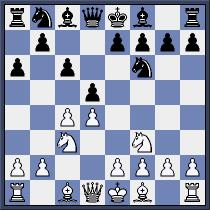
JD - The Chebanenko variation
(4...a6) is a tough nut to crack. Alejandro has used it successfully in
the past including a draw with Kasimdzhanov in the FIDE World
Championship Knockout in Tripoli in 2004.
AR - This silly looking move has
been the fashion slav for some years. The idea is to cover the b5
square, threatening dxc4, but overall to allow the R manouvre to a7,
defending the b7 pawn. You have to love modern chess.
5. c5
AR - This came as a pleasant
surprise. I was expecting Donaldson to attempt a draw after cxd5, and
expect boards 3 and 4 to result in a victory for the SF team.
5....Nbd7
JD - Black has other choices here
but this is currently considered best.
6. Bf4 Nh5 (D)
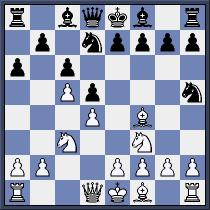
7. Bd2
JD - 7.Bg5 h6 8.Bd2 Nhf6 9. Qc2
Qc7 10. e4 dxe4 11.Nxe4 Nxe4 12.Qxe4 Nf6 13. Qc2 Be6 14. Bd3 Nd7 15. 00
Bd5 16.Rfe1 e6 17. Ne5 Nxe5 18. dxe7 Be7 = Topalov - Kasparov,
Linares 2004
AR - 7.e3 is a bit more popular
then 7. Bd2, but in my opinion both moves present black with problems.
7...Nhf6
JD - 7...g6 8.e4 led to a nice
victory in Gelfand-De la Riva Aguado, Pamplona 2004.
8.Qc2
AR - White prepares the e4 break,
black has no reason to fear it though.
8.....Qc7
AR - and prepares his own break on
e5.
JD - Normally 8....g6 is played
here and I am not sure White has shown a way to an advantage. One
amusing possibility is 9.e4 dxe4 10.Ng5 Bg7 11.Bc4 00 12.Bxf7 Rxf7
13.Ne6 Qe8 14. Nc7 Qd8 15.Ne6 with a draw as 15...Qa5?? drops the queen
to 16.Nxe4 Qb5 17.a4.
Alejandro's move 8...Qc7 caught me by surprise. It
has been played a couple of times in this exact position, and Kasparov
has used it in similar positions, albeit with the inclusion of ....h6
(Bf4-g5-d2, instead of simply Bf4-d2).
9. e4 (D)
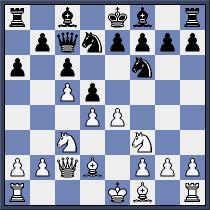
9....Nxe4
JD - 9....dxe4 gives white the
extra option of 10.Ng5, which Lautier used to beat Jakovenko in a blitz
game.
10. Nxe4 dxe4 11. Qxe4 Nd7-f6 (D)
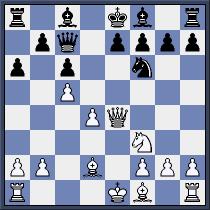
AR - This is an interesting moment
in the game. I was expecting John to play Qe5, as it seemed the most
hazardous:
12. Qc2
AR - yet he prefers to retain the biggest amount of pieces possible in
the game, claiming that his space advantage is more important then his
weak d5 square and d4 pawn.
If 12.Qe5 Qxe5 13.dxe5 Nd5 14.Bc4 g6 with an unclear position.
White has more space but has some structural weaknesses.
JD - The Mechanics' Chess Club's
GM-in-Residence, Alex Yermolinsky, told me after the game that retreat
was not best, that 12.Qe5 looked more testing.
12....Bc8-e6 (! AR)
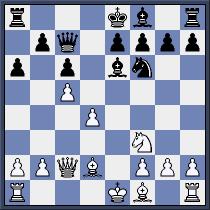
AR - This move is rather
important. Normally chess players would block the d4 pawn with a N, but
in this case the B on d5 will be much more powerful!
13. Bd3 Bd5
JD - 13...Nd7, in comparison with
the Topalov-Kasparov game (but with no ....h6), might be considered.
Alejandro's move certainly looks very natural.
14.O-O-O
JD - Maybe 14. O-O along the
lines of Topalov's play might be right. 14....Bxf3 15.gxf3 e6
leaves White with some ratty looking pawns but he does have space and
two bishops. If Black doesn't take on f3 then Ne5 might come with
effect.
14...g6 15. Ne5 (!? AR) (D)

AR - White realizes that if
he simply develops, he will end up in an inferior position in little
time, so he sacrifices a pawn for the sake of attack.
15...Bg7
AR - Black declines until
there is a better moment. White is forced to play f4-f5 if he is to
continue his play.
JD - 15...Bxg2 16.Rhe1 Bg7 17.f4
Bd5 would transpose to the game but White would get the choice of other
moves besides f4 on move 17.
16. f4 (?! JD)
JD - 16.f3 is more prudent but I thought the text would stop
Black castling either side. This is probably true but Alejandro shows
that it's not so important.
16...Bxg2
AR - I saw no good reason
not to take this pawn now. White has some compensation, but I was
confident in my defensive possibilities.
17. Rhe1 (! AR)
AR - A not so obvious move. Most
people would "regain" their tempo by playing Rhg1, yet that would only
"force" black to play Bd5, a move he wants anyways! The rook is much
better placed in the e file.
17....Bd5
AR - The bishop
goes back to defend f7.
18. f5 (D)
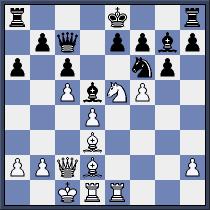
JD - 18.Kb1 was an offhand suggestion made by Yermo after the game. His
thought is that f4-f5 weaken White's grip on the position and he's
probably right.
18...Nd7 (! JD+AR)
AR - A fine tactical mess
issues, where I think John misplayed. White strongest option here is to
exchange knights, and pressure the e pawn.
JD - 18....0-0-0 19.Qa4; 18...0-0
19. Rg1 both look a little scary for Black with Ba5 burying Black's
Queen in one line and sacks on g6 looking tempting in the other, but
Alejandro's decision to trade off White's pieces stops the attack in
its tracks.
19. Nc4 (!? AR)
AR - Very risky, white
sacrifices yet another pawn. I was planning 19.Nxd7 Kxd7! 20.Bc4 Rae8
and blacks pawn is not free, but its a pawn.
JD - I pretty much have to do this
to keep it complicated but now another pawn goes.
19...Bxd4
AR - And black simply takes it! I was aware of the Nd6+ followed by Ba5
line which occured in the game, but saw that white was really gaining
nothing out of it.
20. Nc4-d6+ (D)

AR - 20.Ba5 Qf4 21.Bd2 was
an interesting option. Surely you don't sacrifice 2 pawns to force a
perpetual, but white had to start thinking if his attack would really
crash through.
20...Kd8
JD - 20...Kf8? 21.Bh6 Kg8 22.
Rxe7 would be very nice for white.
21. Ba5 (! AR)
AR - A simple move to see, the
bishop is indirectly protected. Black must have foreseen this
possibility when playing 18...Nd7, otherwise a question mark should be
attached to that move!
21...b6 22. cxb6 Bxb6
AR - 22...Nxb6?? 23.Nxf7 Bxf7
24.Be4! and white wins. It was also important to notice this when
playing 18...Nd7.
23. Bxb6 Nd7xb6 (D)
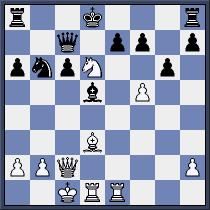
AR - Now black is two pawns
up, and wants to consolidate by playing e6. His king is pretty happy in
the centre of the board. White still has some pressure, and should
create all sort of threats to keep black from consolidating.
24. Nc4
JD - White's intention here
is to trade some minor pieces here to get at Black's King but 24.Ne4
gxf5 25.Nc5 might have been a better try.
24.... gxf5 (! JD)
JD - I think this is the right idea, ensuring that Black has a
strong pawn center to hide his king behind.
25. Qc3
JD - During the game I thought
this interpolation was a good idea but the straightforward 25.Nxb6 Qxb6
26.Bxf5 was not without it's points as my move activates Black's Rook.
25....Rg8 26.Nxb6 Qxb6 27. Bxf5 Rb8 28. Bxh7 Rg8-g2 (D)
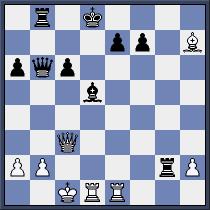
AR - Black is now active
and has an extra pawn. The position should be winning, and whites only
hope is to create murky water in the time trouble we just got in.
29. Bc2
JD - 29.Rd2 allows ....Rxd2
and ...Qb4 or the immediate ...Qb4 but might have been better than the
text. By this point both opponents were getting low on time.
29....Qb4 (! AR)
JD - 29...Rxh2 30. Qe5 Qc7
31. Qxc7 Kxc7 32. Rxe7 Kb6 might have been a good risk-free practical
decsion but at this point the match was still wide open and Alejandro
probably felt he needed to win the game at all costs
(Simutowe-Zilberstein was a one point turnaround in one move).
30. Qh8+
JD - 30.Qe5 f6 wins on the spot
so I need to lure his king up.
30....Kd7 (D)
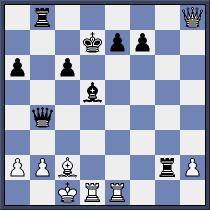
31. Qh8-e5
AR - 31.Rxd5+ cxd5 32. Qh3+ e6 33.Qxg2
Qxe1 and black is winning. If 31.Qh3?! Kc7 and again black has a
winning position.
31....Qc5 (? AR)
AR - Quite messy, Qc4 was much cleaner. Now white gets counterplay due
to his passed h-pawn. After 31...Qc4, white doesn't have the Re2
resource that he used in the game. Black seems almost winning to me.
JD - I was hoping for 31....f6?
32.Rxd5 cxd5 33.Ba4!
32.Re2 Rxe2
JD - 32...Rbg8 looks right.
I am purposely going to refrain from criticizing moves from this point
on because we were both really low on time.I should mention that unlike
the other teams the MI always plays G/60 with 30 second increment
instead of G/90 with a 30 second incrememnt as we are the only team on
the West Coast in the league. (Dallas
always plays G/60 also - Greg Shahade)
Yermo's first impression was that Black should stay with his King
in the center behind his pawns. The queenside doesn't turn out to be a
safe haven.
33. Qxe2 Qb5 34. Bc2-d3 (D)
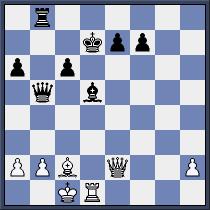
JD - Now the Oracle (aka
Fritz) thinks that White is equal. Some strong players feel that when
you are a pawn down and the computer say you are equal you are actually
better, that is certainly not the case here but the materialist silicon
creature does appreciate the looseness of Black's position.
34...Qc5+
AR - Just trying to gain some
time on the clock.
35. Kb1 a5
JD - 35...Rg8!? (Fritz) 36.Bxa6
Rg1 37.h4 Qd4 38. Rxg1 Qxg1 39.Kc2 Bxa2 looks good for Black. Probably
White should not grab the pawn on a6.
36. Be4
JD - I played this to
loosen Black's King position but 36.h4 looks better
36...e6 37. Qf3
JD - White continues his plan to
open Black up, but now b2 is unguarded. Better was 37.h4
37.....f5
JD - 37...Ke7 following Yermo's
idea to hide behind the pawns makes sense.
38. Qf3-g3 (D)
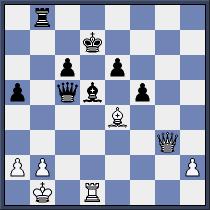
38....Qb4
AR - 38....Rxb2 39.Kxb2 fxe4 was
possible, but white probably has perpetual check somewhere.
JD - 38....Qd6 39.Qg7+ Kc8
safeguards the King.
39. Qg7+ Qe7 40. Qe5 Rb5 41. Bc2 Kc8 42. Qh8+ Qd8 43. Qh8-h7

JD - Cheap threats of Rg1-g8 are
entering White's brain.
43...Rb7 44. Qh6
AR - With time pressure still
going on, it was a relief to see that his queen was unable to give
checks for a while. Black still has an extra pawn and is much better.
JD - I had just enough time left
to appreciate that f6 would be a very nice square for Black's Queen.
44....Kb8
AR - A little trap....
45. h4
AR - 45. Qxe6?? Rxb2+! 46.
Kxb2 Qh8+ and black is winning the white queen.
JD - Finally the right idea
45....Ka7 46. h5 Qb6 47. Qf6
JD - This blunders a pawn
away, instead I should have played 47.Qc1 Bf3 48. Re1 Bxh5 49. Rxe6
47....Qe3
JD - 47...Bf3 48.Re1 Bxh5 49. Bb3
Bf7
48. Ka1 (D)
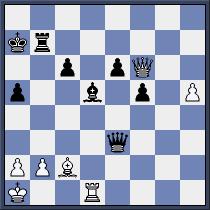
AR - Black is a pawn up and it is
obvious that white has no perpetual check posibilites. Yet, seeing that
my teammate Peter Vavrak had 2 pawns up in a totally winning endgame
while the match was tied at 1-1, I didn't want to risk the match in the
insuing time trouble. I saw the possibility of Bf3 as probably winning,
but decided to allow a perpetual check. I had already offered a draw a
couple of moves ago, but it had been declined.
JD - Another blunder, I saw 48.h6
Rh7 but missed 49.Qd8
48...Qe2
JD - 48...Bf3 does the
trick again. At this point we had around 40 seconds left (with a 30
second increment per move)
AR - 48...Bf3! --+ 49.Rd3
(49.Rb1 Bxh5 50.Bb3 Bf7 and black is won) 49....Qg1+ 50.Bb1 Be4 51.Qd4+
Qxd4 52.Rxd4 and black has all the chances.
49. Qd4+ Kb8 50. Qh8+ Ka7 51. Qd4+
JD - Now I found out that a draw
was not going to be enough as we had lost on boards 2+3. I should have
tried 51.Qc3 hoping for 51...Qxh5? (51...Kb6 and again Black is better)
52. Qxa5+ Kb8 53.Qd8+ Ka7 54. Rd4
Kb8 52. Qh8+ Ka7 53. Qd4+
JD - One check too many, White
has gained some time to think on the clock but alowed a three-time
repetition.
AR - And with this the exciting
game was drawn. It is interesting that whites attack looked so
promising, yet it is (at least for me) impossible to see where he
missed a way to crash into the black fortress.
{Game drawn by repetition} 1/2-1/2
Click here to go back to
the US Chess League
homepage